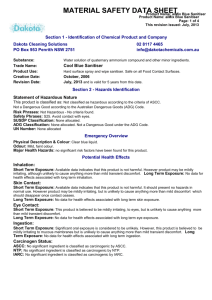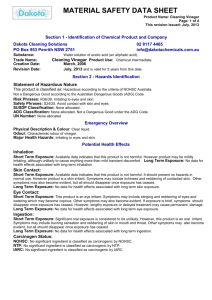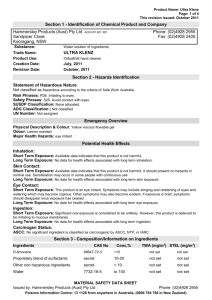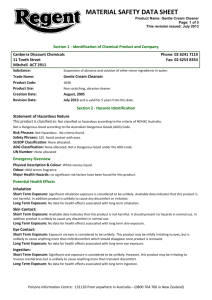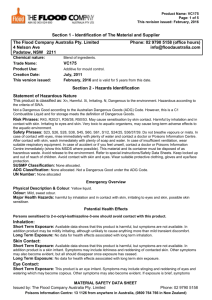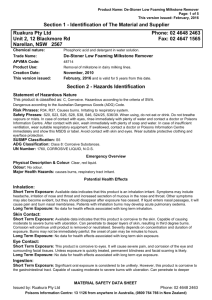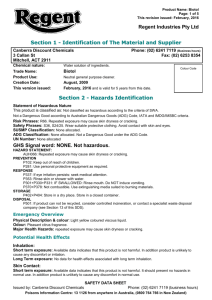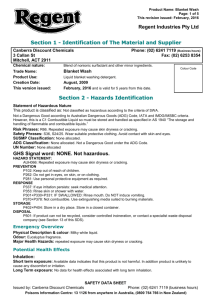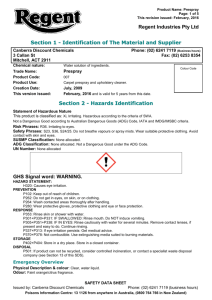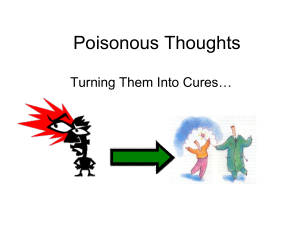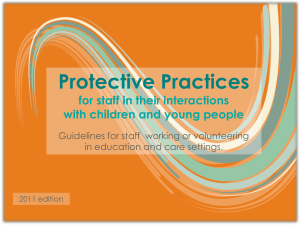levelhardprimer
advertisement
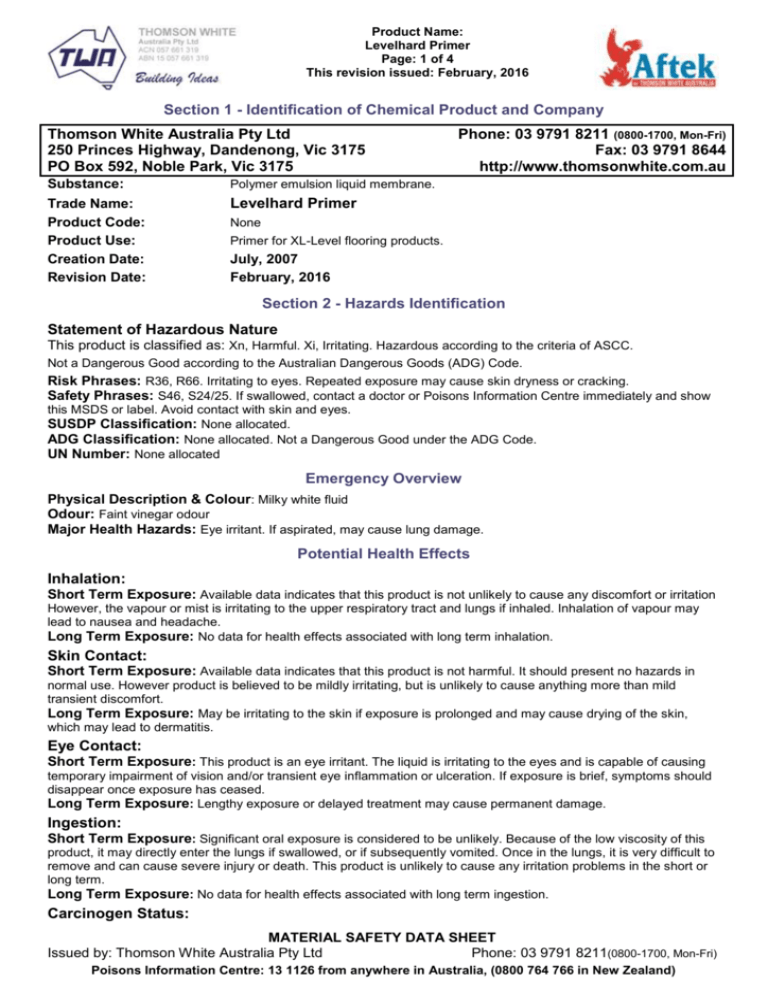
Product Name: Levelhard Primer Page: 1 of 4 This revision issued: February, 2016 Section 1 - Identification of Chemical Product and Company Thomson White Australia Pty Ltd 250 Princes Highway, Dandenong, Vic 3175 PO Box 592, Noble Park, Vic 3175 Substance: Polymer emulsion liquid membrane. Trade Name: Product Code: Product Use: Creation Date: Revision Date: Levelhard Primer Phone: 03 9791 8211 (0800-1700, Mon-Fri) Fax: 03 9791 8644 http://www.thomsonwhite.com.au None Primer for XL-Level flooring products. July, 2007 February, 2016 Section 2 - Hazards Identification Statement of Hazardous Nature This product is classified as: Xn, Harmful. Xi, Irritating. Hazardous according to the criteria of ASCC. Not a Dangerous Good according to the Australian Dangerous Goods (ADG) Code. Risk Phrases: R36, R66. Irritating to eyes. Repeated exposure may cause skin dryness or cracking. Safety Phrases: S46, S24/25. If swallowed, contact a doctor or Poisons Information Centre immediately and show this MSDS or label. Avoid contact with skin and eyes. SUSDP Classification: None allocated. ADG Classification: None allocated. Not a Dangerous Good under the ADG Code. UN Number: None allocated Emergency Overview Physical Description & Colour: Milky white fluid Odour: Faint vinegar odour Major Health Hazards: Eye irritant. If aspirated, may cause lung damage. Potential Health Effects Inhalation: Short Term Exposure: Available data indicates that this product is not unlikely to cause any discomfort or irritation However, the vapour or mist is irritating to the upper respiratory tract and lungs if inhaled. Inhalation of vapour may lead to nausea and headache. Long Term Exposure: No data for health effects associated with long term inhalation. Skin Contact: Short Term Exposure: Available data indicates that this product is not harmful. It should present no hazards in normal use. However product is believed to be mildly irritating, but is unlikely to cause anything more than mild transient discomfort. Long Term Exposure: May be irritating to the skin if exposure is prolonged and may cause drying of the skin, which may lead to dermatitis. Eye Contact: Short Term Exposure: This product is an eye irritant. The liquid is irritating to the eyes and is capable of causing temporary impairment of vision and/or transient eye inflammation or ulceration. If exposure is brief, symptoms should disappear once exposure has ceased. Long Term Exposure: Lengthy exposure or delayed treatment may cause permanent damage. Ingestion: Short Term Exposure: Significant oral exposure is considered to be unlikely. Because of the low viscosity of this product, it may directly enter the lungs if swallowed, or if subsequently vomited. Once in the lungs, it is very difficult to remove and can cause severe injury or death. This product is unlikely to cause any irritation problems in the short or long term. Long Term Exposure: No data for health effects associated with long term ingestion. Carcinogen Status: MATERIAL SAFETY DATA SHEET Issued by: Thomson White Australia Pty Ltd Phone: 03 9791 8211(0800-1700, Mon-Fri) Poisons Information Centre: 13 1126 from anywhere in Australia, (0800 764 766 in New Zealand) Product Name: Levelhard Primer Page: 2 of 4 This revision issued: February, 2016 ASCC: No significant ingredient is classified as carcinogenic by ASCC. NTP: No significant ingredient is classified as carcinogenic by NTP. IARC: Vinyl Acetate Monomer is classed 2b IARC - possibly carcinogenic to humans. See the IARC website for further details. A web address has not been provided as addresses frequently change. Section 3 - Composition/Information on Ingredients Ingredients CAS No Conc,% TWA (mg/m3) STEL (mg/m3) Polyvinyl acetate emulsion 30 - 60 not set not set Vinyl acetate monomer 108-05-4 <0.1 35 70 Other non-hazardous ingredients secret to 100 not set not set This is a commercial product whose exact ratio of components may vary slightly. Minor quantities of other non hazardous ingredients are also possible. The ASCC TWA exposure value is the average airborne concentration of a particular substance when calculated over a normal 8 hour working day for a 5 day working week. The STEL (Short Term Exposure Limit) is an exposure value that may be equalled (but should not be exceeded) for no longer than 15 minutes and should not be repeated more than 4 times per day. There should be at least 60 minutes between successive exposures at the STEL. The term "peak "is used when the TWA limit, because of the rapid action of the substance, should never be exceeded, even briefly. Section 4 - First Aid Measures General Information: You should call The Poisons Information Centre if you feel that you may have been poisoned, burned or irritated by this product. The number is 13 1126 from anywhere in Australia (0800 764 766 in New Zealand) and is available at all times. Have this MSDS with you when you call. Inhalation: First aid is not generally required. If in doubt, contact a Poisons Information Centre or a doctor. Skin Contact: Wash gently and thoroughly with water (use non-abrasive soap if necessary) for 10 minutes or until chemical is removed. If irritation persists, repeat flushing and obtain medical advice. Eye Contact: Immediately flush the contaminated eye(s) with lukewarm, gently flowing water for 20 minutes or until the product is removed, while holding the eyelid(s) open. Take care not to rinse contaminated water into the unaffected eye or onto the face. Obtain medical attention immediately. Take special care if exposed person is wearing contact lenses. Ingestion: If swallowed, do NOT induce vomiting. Wash mouth with water and contact a Poisons Information Centre, or call a doctor. Section 5 - Fire Fighting Measures Fire and Explosion Hazards: There is no risk of an explosion from this product under normal circumstances if it is involved in a fire. Fire decomposition products from this product are not expected to be hazardous or harmful. Extinguishing Media: Not Combustible. Use extinguishing media suited to burning materials. Fire Fighting: Flash point: Not flammable. Upper Flammability Limit: No data. Lower Flammability Limit: No data. Autoignition temperature: No data. Flammability Class: No data. Section 6 - Accidental Release Measures Accidental release: In the event of a major spill, prevent spillage from entering drains or water courses. Wear full protective clothing including eye/face protection. All skin areas should be covered. See below under Personal Protection regarding Australian Standards relating to personal protective equipment. Suitable materials for protective clothing include rubber. Eye/face protective equipment should comprise as a minimum, protective glasses and, preferably, goggles. If there is a significant chance that vapours or mists are likely to build up in the cleanup area, we recommend that you use a respirator. Usually, no respirator is necessary when using this product. However, if you have any doubts consult the Australian Standard mentioned below (section 8). Stop leak if safe to do so, and contain spill. Absorb onto sand, vermiculite or other suitable absorbent material. If spill is too large or if absorbent material is not available, try to create a dike to stop material spreading or going into drains or waterways. Sweep up and shovel or collect recoverable product into labelled containers for recycling or salvage, and dispose of promptly. Recycle containers wherever possible after careful cleaning. After spills, wash area preventing runoff from entering drains. If a significant quantity of material enters drains, advise emergency services. MATERIAL SAFETY DATA SHEET Issued by: Thomson White Australia Pty Ltd Phone: 03 9791 8211 Poisons Information Centre: 13 1126 from anywhere in Australia, (0800 764 766 in New Zealand) Product Name: Levelhard Primer Page: 3 of 4 This revision issued: February, 2016 This material may be suitable for approved landfill. Ensure legality of disposal by consulting regulations prior to disposal. Thoroughly launder protective clothing before storage or re-use. Advise laundry of nature of contamination when sending contaminated clothing to laundry. Section 7 - Handling and Storage Handling: Keep exposure to this product to a minimum, and minimise the quantities kept in work areas. Check Section 8 of this MSDS for details of personal protective measures, and make sure that those measures are followed. The measures detailed below under "Storage" should be followed during handling in order to minimise risks to persons using the product in the workplace. Also, avoid contact or contamination of product with incompatible materials listed in Section 10. Storage: Store packages of this product in a cool place. Make sure that containers of this product are kept tightly closed. Keep containers dry and away from water. Make sure that the product does not come into contact with substances listed under "Incompatibilities" in Section 10. Some liquid preparations settle or separate on standing and may require stirring before use. Check packaging - there may be further storage instructions on the label. Section 8 - Exposure Controls and Personal Protection The following Australian Standards will provide general advice regarding safety clothing and equipment: Respiratory equipment: AS/NZS 1715, Protective Gloves: AS 2161, Industrial Clothing: AS2919, Industrial Eye Protection: AS1336 and AS/NZS 1337, Occupational Protective Footwear: AS/NZS2210. ASCC Exposure Limits TWA (mg/m3) STEL (mg/m3) Vinyl acetate monomer 35 70 No special equipment is usually needed when occasionally handling small quantities. The following instructions are for bulk handling or where regular exposure in an occupational setting occurs without proper containment systems. Ventilation: This product should only be used where there is ventilation that is adequate to keep exposure below the TWA levels. If necessary, use a fan. Eye Protection: Protective glasses or goggles should be worn when this product is being used. Failure to protect your eyes may cause them harm. Emergency eye wash facilities are also recommended in an area close to where this product is being used. Skin Protection: You should avoid contact even with mild skin irritants. Therefore you should wear suitable impervious elbow-length gloves and facial protection when handling this product. See below for suitable material types. Protective Material Types: We suggest that protective clothing be made from the following materials: rubber. Respirator: Usually, no respirator is necessary when using this product. However, if you have any doubts consult the Australian Standard mentioned above. Eyebaths or eyewash stations should be provided near to where this product is being used. Section 9 - Physical and Chemical Properties: Physical Description & colour: Odour: Boiling Point: Freezing/Melting Point: Volatiles: Vapour Pressure: Vapour Density: Specific Gravity: Water Solubility: pH: Volatility: Odour Threshold: Evaporation Rate: Coeff Oil/water Distribution: Autoignition temp: Milky white fluid Faint vinegar odour 100°C at 100kPa. No specific data. Liquid at normal temperatures. No data. As for water No data. 1.05 Miscible. No data. No data. No data. No data. No data No data. Section 10 - Stability and Reactivity Reactivity: This product is unlikely to react or decompose under normal storage conditions. However, if you have any doubts, contact the supplier for advice on shelf life properties. Conditions to Avoid: This product should be kept in a cool place, preferably below 30°C. Keep containers tightly closed. Containers should be kept dry. MATERIAL SAFETY DATA SHEET Issued by: Thomson White Australia Pty Ltd Phone: 03 9791 8211 Poisons Information Centre: 13 1126 from anywhere in Australia, (0800 764 766 in New Zealand) Product Name: Levelhard Primer Page: 4 of 4 This revision issued: February, 2016 Incompatibilities: No particular Incompatibilities. Fire Decomposition: Carbon monoxide may be produced on burning dry film Polymerisation: Polymerisation reactions are unlikely; they are not expected to occur. Section 11 - Toxicological Information Local Effects: Target Organs: There is no data to hand indicating any particular target organs. Classification of Hazardous Ingredients Ingredient Risk Phrases No ingredient mentioned in the HSIS Database is present in this product at hazardous concentrations. Section 12 - Ecological Information This product is biodegradable. It will not accumulate in the soil or water or cause long term problems. Section 13 - Disposal Considerations Disposal: There are many pieces of legislation covering waste disposal and they differ in each state and territory, so each user must refer to laws operating in their area. In some areas, certain wastes must be tracked. The Hierarchy of Controls seems to be common - the user should investigate: Reduce, Reuse, and Recycle and only if all else fails should disposal be considered. Note that properties of a product may change in use, so that the following suggestions may not always be appropriate. The following may help you in properly addressing this matter for this product. This product may be recycled if unused, or if it has not been contaminated so as to make it unsuitable for its intended use. If it has been contaminated, it may be possible to reclaim the product by filtration, distillation or some other means. If neither of these options is suitable, consider controlled incineration, or landfill. Section 14 - Transport Information ADG Code: This product is not classified as a Dangerous Good. No special transport conditions are necessary unless required by other regulations. Section 15 - Regulatory Information AICS: All of the significant ingredients in this formulation are compliant with NICNAS regulations. Section 16 - Other Information This MSDS contains only safety-related information. For other data see product literature. Acronyms: ADG Code AICS ASCC CAS Number Hazchem Code IARC NOS NTP R-Phrase SUSDP UN Number Australian Code for the Transport of Dangerous Goods by Road and Rail Australian Inventory of Chemical Substances Office of the Australian Safety and Compensation Council Chemical Abstracts Service Registry Number Emergency action code of numbers and letters that provide information to emergency services especially firefighters International Agency for Research on Cancer Not otherwise specified National Toxicology Program (USA) Risk Phrase Standard for the Uniform Scheduling of Drugs & Poisons United Nations Number THIS MSDS SUMMARISES OUR BEST KNOWLEDGE OF THE HEALTH AND SAFETY HAZARD INFORMATION OF THE PRODUCT AND HOW TO SAFELY HANDLE AND USE THE PRODUCT IN THE WORKPLACE. EACH USER MUST REVIEW THIS MSDS IN THE CONTEXT OF HOW THE PRODUCT WILL BE HANDLED AND USED IN THE WORKPLACE. IF CLARIFICATION OR FURTHER INFORMATION IS NEEDED TO ENSURE THAT AN APPROPRIATE RISK ASSESSMENT CAN BE MADE, THE USER SHOULD CONTACT THIS COMPANY SO WE CAN ATTEMPT TO OBTAIN ADDITIONAL INFORMATION FROM OUR SUPPLIERS OUR RESPONSIBILITY FOR PRODUCTS SOLD IS SUBJECT TO OUR STANDARD TERMS AND CONDITIONS, A COPY OF WHICH IS SENT TO OUR CUSTOMERS AND IS ALSO AVAILABLE ON REQUEST. Please read all labels carefully before using product. This MSDS is prepared in accord with the ASCC document “National Code of Practice for the Preparation of Material Safety Data Sheets” 2nd Edition [NOHSC:2011(2003)] Copyright © Kilford & Kilford Pty Ltd, February, 2016. http://www.kilford.com.au/ Phone (02)9251 4532 MATERIAL SAFETY DATA SHEET Issued by: Thomson White Australia Pty Ltd Phone: 03 9791 8211 Poisons Information Centre: 13 1126 from anywhere in Australia, (0800 764 766 in New Zealand)
